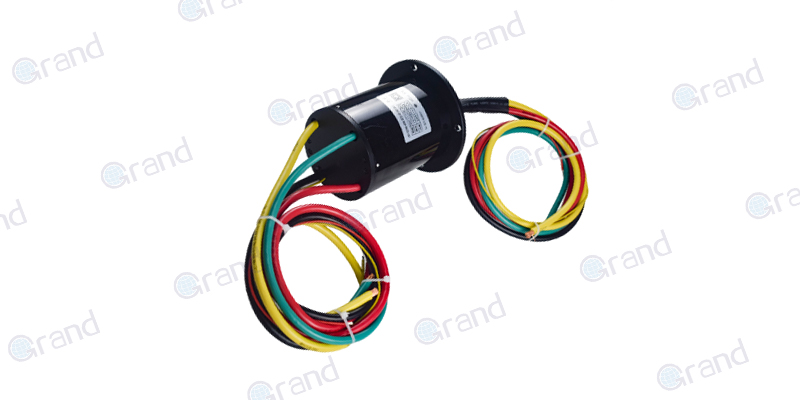Winch slip rings have become an essential component in many industries, particularly in applications that require the transfer of power and signals between stationary and rotating parts. They are often used in marine, construction, and wind energy applications, as well as various other fields. The versatility, reliability, and durability of winch slip rings make them an ideal solution to various challenges faced by professionals in these industries. As technology continues to advance, the need for efficient and reliable systems in various industries has grown. One such system that has gained prominence is the slip ring winch. In this complete guide, we’ll explore the fundamentals of winch slip rings, their components, features, benefits, types, and practical applications. We’ll also touch upon installation, troubleshooting, maintenance, and the future of winch slip rings, along with answering some frequently asked questions.
What are Winch Slip Rings?
As we venture deeper into an increasingly mechanized and technologically driven world, understanding the complex devices and components that keep these systems functioning smoothly is not only fascinating but important. Among these, the concept of winch slip rings stands out as an integral part of many modern systems.
Winch slip rings, also known as rotary electrical interfaces or rotating electrical connectors, are intricate electromechanical devices that play a critical role in a variety of industrial machinery and wind turbines, to name a few. These devices facilitate the transfer of electrical power and data signals from a stationary part, often referred to as the stator, to a rotating part, known as the rotor, and vice versa. In simpler terms, they can be thought of as a rotating extension cord, allowing power or data to be continuously transmitted, even as the connected tool or machinery turns or rotates.
The name ‘winch’ comes from one of the most common applications of this equipment. In a typical winch system, the rotating drum, which winds and unwinds the cable, requires a continuous power supply, while also needing to turn freely. This is made possible through the use of a winch slip ring assembly.
Functionally, winch slip rings provide a solution to the problem of supplying power and transmitting data to and from a continually rotating component. Without the use of a slip ring, power cables would get twisted or tangled, potentially causing damage, and disrupting the operation.
Aside from winches, slip rings find use in a wide array of applications, spanning various industries such as wind energy, where they enable power and signal transmission in wind turbines, in the military for use in radar antennae and gun turrets, and even in the medical field for CT scanners. Despite being quite varied in their application, the foundation remains consistent – facilitating uninterrupted power and data transfer between stationary and rotating parts.
With the continuous advancement in technology and equipment design, the role of winch slip rings is set to become even more significant, reinforcing their importance in today’s growing industrial scenario. Having now established a foundational understanding of what winch slip rings are, and their function and use, we can delve deeper into the specifics, components, types, and intricacies of these indispensable devices.
Components of a Winch Slip Ring
A winch slip ring may appear to be a simple device externally, but within its casing, it hosts an array of intricate parts working synergistically to perform consistently and efficiently. Each component plays a significant role, contributing towards the device’s primary function of conveying power and data signals between a stationary source and a rotating part without causing any interruptions or distortions.
Housing
The housing is the external part of the winch slip ring that encases and offers protection to the internal components. It is usually made from robust materials like metal or high-grade plastic that can withstand harsh operating conditions and resist wear and tear. The housing also prevents environmental contaminants such as dust, dirt, and moisture from accessing and impacting the performance and longevity of the internal components.
Rotor
The rotor is the rotating component of the winch slip ring. It connects to the rotating object within the system. The rotor continuously spins during system operation and is linked to the slip ring surface, enabling electrical signals and power to be transmitted from the stationary part to the rotating component.
Stator
The stator is the stationary part of the device that is fixed to the non-moving portion of the system. The brushes within the stator maintain contact with the slip ring surface on the rotor, ensuring a continual connection despite the rotational movement of the object to which the slip ring is connected.
Brushes
Brushes are small conductive components, often made of metal or graphite, that maintain constant contact with the slip ring surface during rotation. These brushes are crucial in transferring electrical signals and power from the stationary component to the rotating part, thereby permitting the continual operation of connected circuits or systems.
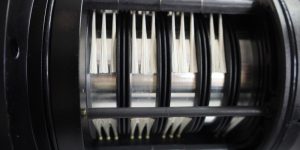
Slip Ring Surface
The slip ring surface, typically made of conductive materials like copper or other metals, is a critical part of the assembly. The brushes glide over this surface, facilitating a smooth transfer of electricity between static and rotating parts. Despite the constant friction, the slip ring surface is designed to resist wear and tear, ensuring a long lifespan.
As you’ll image, each part of the winch slip ring works in tandem with the others. High-grade housing protects its gentle internal workings from environmental damage. The rotor and the stator, central to the device’s function, form a rotating-stationary pair, bridged by the brushes and slip ring surface. This ensures the constant transfer of power and signals, even as one part spins and the other remains still, eliminating the issues of tangling or breaking that may otherwise disrupt the flow of power or data. In essence, the concert between these individual parts forms the heartbeat of any system that employs a winch slip ring.
How Winch Slip Rings Work
Winch slip rings are integral components in various applications for their ability to transmit electrical power and data signals between stationary and rotating parts consistently and effectively. This eliminates the inherent limitations and risks of twisted cables and disrupted communication.
The Principles Behind the Functioning of Winch Slip Rings:
The operation of winch slip rings is based on maintaining continuous electrical contact between a stationary component (stator) and a rotating part (rotor). The fundamental purpose is to ensure power and data transmission remain uninterrupted despite the relative motion of the parts. The slip rings must allow for a smooth exchange of electrical current while reducing any resulting friction and wear to ensure a long-lasting and efficient operation.
The Role of Each Part in Its Function:
Each component of a winch slip ring plays a crucial role in fulfilling the device’s core function:
- Housing: The housing provides structural support and protection to the delicate internal components, shielding them from environmental contaminants, external forces, and possible mechanical wear-and-tear.
- Rotor: The rotor connects to the rotating part of the system and spins synchronously with it. It is responsible for transferring the power or data signals from one side of the slip ring to the other.
- Stator: The role of the stator is to connect the stationary side of the electrical system with the power source or signal generator. It works in conjunction with the brushes to maintain continuous electrical contact with the slip ring surface, ensuring reliable and efficient transfer of power and data signals.
- Brushes: As the contact point between the stationary and rotating parts, brushes must consistently maintain contact with the slip ring surface despite the latter’s constant motion. They transfer the electrical current between the stator and the rotor, allowing for signal and power transmission across the rotating boundary.
- Slip Ring Surface: The slip ring surface provides the conductive path through which electrical current is transferred between the brushes and the rotor. This surface must be made of durable, conductive material that can withstand continuous motion without excessive wear or loss of efficiency.
The combined functionality of these components ensures that winch slip rings serve their purpose in a wide variety of applications.
Importance of Winch Slip Rings in Various Applications:
Winch slip rings have become essential parts of many mechanical systems that involve power and data transfer between stationary and rotating components. Their importance lies in their ability to:
- Solve challenges associated with cable twisting or tangling during system rotation
- Provide smooth, consistent, and efficient performance in varying environments
- Ensure the continuous power supply to critical systems or equipment
- Enable the continuous transmission of data signals for monitoring and control purposes
Winch slip rings are employed in numerous industries and applications, ranging from wind turbines and radar systems to medical equipment like CT scanners and cable management systems. Their versatility and efficiency contribute to their significance in a wide array of modern technologies.
In summary, understanding how winch slip rings work and the critical role of each of their components helps us appreciate the critical roles these devices play across various applications. Their importance in enabling reliable signal and power transmission between stationary and rotating parts helps ensure the smooth operation of many electrical and mechanical systems.
Features of Winch Slip Rings
Winch slip rings display a host of unique features, each serving an essential role in their functionality and efficiency. The diverse array of features they possess is the reason behind their wide range of applications within various industries.
List and Description of Key Features:
- Compact Design: Despite their robust capabilities, winch slip rings are often designed to be compact, allowing them to fit within a wide array of systems without occupying much space. This makes them an ideal solution for applications that have space constraints. Their compactness, however, does not detract from their performance or endurance.
- Durability: Slip rings are built to endure harsh environmental conditions and function consistently despite extended periods of use. They generally feature robust housing and high-grade conductive materials capable of withstanding wear and tear from continuous operation.
- Versatility: Slip rings are designed to transmit a variety of signals, ranging from power, regular data, Ethernet, and USB, to even high-definition video signals. Thanks to this, they can serve diverse applications across several industries.
- Reliable Performance: Slip rings offer reliable performance by maintaining constant electrical contact between rotating and stationary components. They can support high rotating speeds while ensuring the effective transmission of signals and power.
- Low Electrical Noise: High-quality winch slip rings are designed to have low electrical noise, which is crucial for preserving signal integrity during transmission, particularly vital for sensitive data and control signals.
Significance of These Features and Their Impacts:
Each feature of a winch slip ring contributes significantly to its functionality:
- Compact Design: The compactness of slip rings allows them to be integrated seamlessly into systems without much retrofitting, thereby saving installation space and reducing overall system size.
- Durability: Durable materials lengthen their lifespan, providing cost-efficiency and reducing replacement rates. This durability ensures reliable performance even under challenging operating conditions.
- Versatility: The versatility of winch slip rings makes them suitable for a broad spectrum of applications, ranging from heavy-duty industrial machinery to delicate scientific equipment, thus widening their market.
- Reliable Performance: The ability of slip rings to maintain electrical contact despite rotation ensures signal integrity, thereby contributing to the consistent and reliable operation of the attached systems.
- Low Electrical Noise: Low electrical noise contributes to better signal quality, particularly important in applications involving the transmission of sensitive data or control signals, thereby improving overall system performance.
In summary, the wide array of features that winch slip rings offer is what makes them an essential inclusion in various systems that require power or signal transfer between rotating and stationary parts. Their diverse features give them the flexibility and durability to handle a wide range of tasks, ensuring both efficiency and longevity. Understanding these features not only helps in choosing the right slip ring for an application but also in ensuring their optimal utilization and maintenance.
Benefits of Using Winch Slip Rings
Winch slip rings are integral components that bring several benefits to applications that require reliable signal and power transmission between static and rotating parts. Their distinctive features set them apart from alternatives and endorse their growing popularity within multiple industries.
Various Advantages of Incorporating Winch Slip Rings in Different Applications:
- Uninterrupted Signal and Power Transmission: Winch slip rings ensure continuous signal and power transfer, avoiding issues related to cable twisting or tangling, which are common in rotational applications.
- Versatility: With the capacity to handle a variety of signals (power, regular data, Ethernet, USB, high definition video signals) in different conditions, winch slip rings are versatile components that can be employed in a gamut of industries and applications.
- Compact and Durable: The compactness of slip rings makes them suitable for systems with space constraints. Furthermore, their durability reduces maintenance needs and improves overall system reliability.
- Elimination of Noise and Interference: Slip rings minimize electrical noise, preserving signal integrity during transmission, even in applications that require high rotational speed.
- Cost-Efficiency: The longevity and reduced maintenance of slip rings can lead to significant cost savings, improving the overall cost-effectiveness of the systems they are integrated into.
Comparisons to Other Systems or Alternatives, Showing the Benefits of Using Winch Slip Rings:
When compared to alternative solutions such as swivel joints or wireless devices, slip rings offer several advantages:
- Versus Swivel Joints: Swivel joints are mechanical devices that allow rotation but often struggle with high-speed transmission of signals. In contrast, winch slip rings can handle high-speed rotations and a variety of signal types effectively.
- Versus Wireless Devices: While wireless technologies are increasingly popular, they can sometimes be prone to interference or have limited range. Slip rings, on the other hand, ensure reliable, uninterrupted signal and power transmission without the constraints of distance or the risk of signal interference.
- Versus Traditional Cables: Compared to traditional cable systems, winch slip rings avoid issues of cable twisting and tangling during rotation. Moreover, their compact design and durability offer clear advantages in terms of space-needed and product lifespan.
In conclusion, winch slip rings offer numerous benefits for numerous applications, ensuring their place as crucial components within systems requiring power and signal transmission between stationary and rotating components. The advantages offered in terms of uninterrupted transmission, versatility, compactness, signal integrity, and cost-efficiency set them apart from other alternatives, making them the preferred choice for a variety of applications across different industries.
Types of Winch Slip Rings
The diverse requirements of various applications necessitate the availability of different types of winch slip rings. Each type is carefully engineered to excel in specific parameters and is best suited for certain applications.
Description of the Different Types of Winch Slip Rings, Comparison and Contrast:
Conductive Slip Rings
Also known as brush slip rings, these are the most common type, consisting of a conductive ring and a brush or wire that maintains contact as the ring rotates. These are usually favored for their simplicity, effectiveness, and cost-effectiveness. However, they come with potential downsides of wear due to friction and higher maintenance due to required brush replacements.
Fibre Optic Rotary Joints (FORJs)
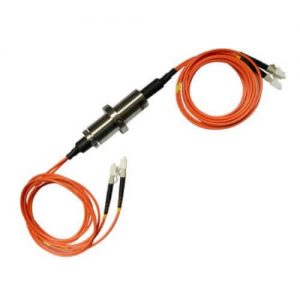
These special types of slip rings are used for transmitting optical signals. FORJs maintain their alignment exceptionally well, allowing high data rate transmissions. However, they are more complex and expensive compared to standard conductive slip rings.
Wireless Slip Rings
As the name suggests, these slip rings transfer power and data wirelessly, eliminating physical contact and thus friction entirely. They offer high-performance data transmission but can be more expensive and can potentially be affected by environmental factors.
Capsule Slip Rings
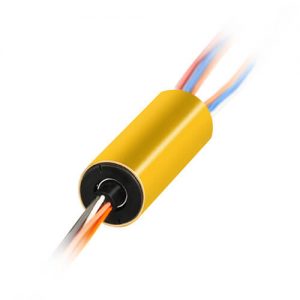
These slip rings are small and compact, designed for transmitting signals and power in devices with limited installation space. While they offer a space-efficient solution, they may not be suitable for high-power transmission due to size constraints.
Pancake Slip Rings
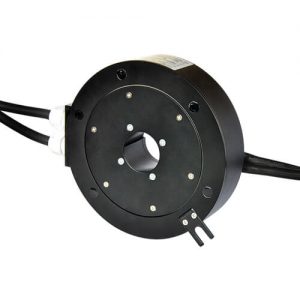
These are designed as flat, disc-shaped units that are ideal for applications with height restrictions but enough radial space. However, due to their design, they may accumulate more debris and hence require more frequent maintenance.
Situation or Application Best Suited for Each Type:
- Conductive Slip Rings: Given their simple design and cost-effectiveness, these are an excellent choice for general applications that require reliable power and signal transfer at a reasonable cost.
- Fibre Optic Rotary Joints: FORJs are ideal for high-data-rate applications like radar systems, CAT scanners, or certain military technologies where high-speed and error-free transmission is critical.
- Wireless Slip Rings: These slip rings are well suited for applications that demand high-speed data transmission or where physical wire connections might be challenging or impractical due to environmental conditions.
- Capsule Slip Rings: These are perfect for small devices like cameras, medical equipment, or robotics, where space is limited and signal transmission is more critical than high-power transmission.
- Pancake Slip Rings: Pancake slip rings work best in situations where there is ample radial space but limited axial or vertical space, such as in some types of industrial machinery or robotics.
In summary, the type of winch slip ring chosen often depends on the specific requirements of the application, including factors like space constraints, data transmission needs, costs, and more. Understanding the different types of slip rings allows for more informed decision-making when incorporating these useful devices into varying applications.
Installation of Winch Slip Rings
Installing winch slip rings involves a careful and sequential process, ensuring the safe and efficient operation of the device. To guarantee optimal functionality and longevity, several precautions need to be taken into account during installation.
A Step-by-Step Guide on How to Set Up Winch Slip Rings:
- Unpack and Inspect: Unpack the slip ring carefully, ensuring all parts are present and undamaged. Check the user manual or guide that comes with the product for a list of components.
- Prepare Installation Site: Ensure the machine or device where the slip ring will be installed is clean and free from debris. The location should be accessible and have enough space for the slip ring.
- Mount the Slip Ring: Position the slip ring in its designated place on the device per the installation instructions. Use the recommended hardware (like screws and brackets) to secure it firmly in place.
- Connect Cables: Carefully connect the necessary cables to their designated ports on the slip ring. Make sure to use appropriate cable connectors and follow the provided wiring diagram.
- Securing and Protection: Secure any loose cables with ties and cover the slip ring, if applicable, to protect it from dust or external damage.
- Testing: Before fully operating the machine, conduct a preliminary test to confirm that the slip ring is working correctly and the connections are secure.
Necessary Precautions to be Aware of During Installation:
- Understand the Manual: Before starting the installation process, thoroughly understand the user manual or installation guide provided with the slip ring to avoid making errors.
- Handle Gently: Handle the slip ring with care during unpacking and installation. Slip rings can contain delicate parts which, if mishandled, could affect their performance.
- Safety Measures: Always disconnect power to the machine or device during installation to avoid electric shock.
- Correct Connections: Ensure all wires are connected to the correct terminals to avoid short circuits or damage to the slip ring or the machine it is being installed into.
- Proper Mounting: Ensure the slip ring is mounted sturdily and securely to avoid excessive vibration or movement during the operation, which could lead to damage or wear.
In essence, installing a winch slip ring is a precise operation that, when performed correctly, will enable the device to work optimally and have a long service life. By bearing in mind the necessary precautions, you can also ensure that the process is carried out securely.
Troubleshooting and Maintenance of Winch Slip Rings
Like any mechanical device, winch slip rings can experience issues and malfunctions due to normal wear and tear or improper use. Knowing how to troubleshoot these problems can help to reduce downtime and expensive repairs. Regular maintenance is also essential in ensuring longevity and efficiency.
Common Issues Users Might Encounter:
- Signal Loss or Intermittency: This problem can manifest itself in the form of erratic behavior or total loss of signal. It usually suggests issues with the integrity of the contacts or the cables.
- Noise or Interference in Signal: This usually indicates that electrical noise or a signal interference source may be present, affecting the transmission.
- Excessive Wear or Damage: Visual inspection may reveal physical wear on the slip rings or brushes, or even damage on other mechanical components.
How to Troubleshoot These Issues:
- Signal Loss or Intermittency: Check the integrity of the connections (wire connections and brush/ring interface). Confirm if the cables are properly connected and free from damage. If necessary, clean the contacts using recommended cleaning agents.
- Noise or Interference in Signal: Ensure that all grounding connections are secure. Look for potential sources of electromagnetic interference (for example, other high-powered devices) and, if found, try to physically separate them from the winch slip ring.
- Excessive Wear or Damage: Physically damaged or excessively worn parts should be replaced. Be sure to use parts recommended by the manufacturer to ensure compatibility and performance.
Tips for Maintaining Winch Slip Rings to Ensure Longevity and Efficiency:
- Regular Inspection: To spot issues early on, it is important to inspect the slip ring system regularly. Look for signs of wear, damage, or looseness on the contacts and other components.
- Frequent Cleaning: Keeping the slip ring clean from dust and debris can prolong its useful life. Use recommended cleaning agents and procedures provided by the manufacturer.
- Re-lubricating When Needed: Some slip rings might need occasional lubrication to ensure smooth operation and reduce wear. This should be done cautiously, using the correct lubricant recommended by the manufacturer, to avoid contamination of the contacts.
- Proper Storage: If the system is expected to remain idle for an extended period, it should be stored properly. Select a cool and dry location and cover the slip ring system to protect it from dust and moisture.
In summary, troubleshooting and maintaining your winch slip ring well can help you quickly resolve minor issues before they escalate and to sustain the slip ring’s performance over the long term. These tips should make this process more manageable and help you get the most from your winch slip ring.
Recent Advances and Future of Winch Slip Rings
In recent years, advancements in technology have ushered in innovations and improvements in various fields, including winch slip rings. These progressions are not only enhancing the performance of the devices but also shaping the future of the industry.
Recent Technological Innovations in Winch Slip Rings:
- Improved Materials and Coatings: The use of advanced materials (such as precious metal alloys) and coatings has made it possible to reduce friction and minimize wear on the contact surfaces. This innovation has resulted in improved efficiency, signal transmission quality, and longer service life of the winch slip rings.
- Integration of FORJs: Incorporating fiber optic rotary joint (FORJ) technology into slip rings has significantly enhanced the bandwidth and enabled the reliable transmission of video, data, and high-frequency signals, which is vital in various applications like telecommunications and surveillance.
- Compact Designs and Miniaturization: Advances in engineering have allowed the development of smaller and more compact slip ring designs, referred to as capsule slip rings. These have several applications in robotics, medical devices, and other areas requiring limited space for operation.
Predictions and Trends for Future Development:
- Increased Adoption of Wireless Slip Rings: As the demand for fast, reliable, and high-speed data transmission grows, wireless slip rings could become more widespread. Since they minimize friction and wear by eliminating physical contact, the adoption of wireless technology could be a game-changer in the industry.
- More Advanced Diagnostic and Monitoring Features: The addition of built-in diagnostic and monitoring technology will enable real-time assessment of slip ring performance, facilitating predictive maintenance to extend component life and reduce downtime.
- Elevated Integration with IoT and AI: The increasing convergence of winch slip rings with IoT (Internet of Things) and AI (Artificial Intelligence) based systems will further enhance data communication capabilities and allow for more sophisticated applications.
- Environmentally Friendly Materials and Processes: As environmental considerations become essential, the development and use of eco-friendly materials and manufacturing processes may become an integral aspect of the winch slip rings industry.
In conclusion, recent technological innovations in winch slip rings are paving the way for better performance, efficiency, and adaptability to future needs. As the industry evolves, we can expect more breakthroughs and advancements that will reshape the slip rings market and the variety of applications it serves.
Conclusion
To recap, this comprehensive article has covered a wide range of aspects surrounding winch slip rings, including their functionality, installation, troubleshooting, and maintenance, as well as recent advances and future perspectives in the field.
We’ve examined the design and operation of winch slip rings, with reference to their key role in maintaining continuous power and signal transmission in a rotating system. And highlighted the criticality of correct installation procedures, where careful handling and precise connections can ensure long-term performance.
When it comes to troubleshooting and maintenance, we’ve underlined the significance of regular inspection, cleaning, and proper storage. These aspects are crucial for prolonging the life of a slip ring and ensuring its optimal functionality.
Given the recent technological advancements in the field, we’ve seen how winch slip rings have evolved with improved materials, integration of FORJs, and miniaturized designs. Looking ahead, it’s anticipated that developments such as wireless slip rings, advanced diagnostics features, and integrations with IoT and AI will continue to reshape this market for the better.
As a final note, it’s essential to realize that with all mechanical components, including winch slip rings, prevention is better than cure. Regular precautionary measures, such as timely maintenance and checks, can ensure smooth operation and help avoid unforeseen issues. Also, keeping up to speed with emerging trends and innovations will enable users to harness the full potential of these vital devices and be prepared for future advancements.
FAQs About Winch Slip Ring
Q: What is the lifespan of a winch slip ring?
A: The lifespan of a winch slip ring depends on factors such as usage and environmental conditions. However, with proper maintenance, winch slip rings can have a long service life, lasting several years.
Q: Can winch slip rings be customized?
A: Yes, winch slip ring manufacturers can often customize slip rings to suit specific project requirements, including size, electrical capacity, and materials used.
Q: Are winch slip rings only used in winch applications?
A: Though the name suggests otherwise, winch slip rings can be applied across various industries and applications that involve transferring power and signals between stationary and rotating components.
See What We Can Do

